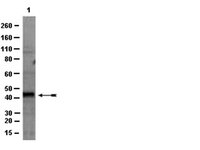07-1548 Sigma-AldrichAnti-HDAC11 Antibody
Use Anti-HDAC11 Antibody (Rabbit Polyclonal Antibody) validated in WB, ELISA, IHC to detect HDAC11 also known as histone deacetylase 11.
More>> Use Anti-HDAC11 Antibody (Rabbit Polyclonal Antibody) validated in WB, ELISA, IHC to detect HDAC11 also known as histone deacetylase 11. Less<<Recommended Products
Áttekintés
| Replacement Information |
|---|
Kulcsspecifikációk táblázata
| Species Reactivity | Key Applications | Host | Format | Antibody Type |
|---|---|---|---|---|
| H, M | WB, ELISA, IHC | Rb | Purified | Polyclonal Antibody |
| References |
|---|
| Product Information | |
|---|---|
| Format | Purified |
| Control |
|
| Presentation | Purified rabbit polyclonal in buffer containing 0.09% NaN3. |
| Quality Level | MQ100 |
| Physicochemical Information |
|---|
| Dimensions |
|---|
| Materials Information |
|---|
| Toxicological Information |
|---|
| Safety Information according to GHS |
|---|
| Safety Information |
|---|
| Packaging Information | |
|---|---|
| Material Size | 400 µl |
| Transport Information |
|---|
| Supplemental Information |
|---|
| Specifications |
|---|
| Global Trade Item Number | |
|---|---|
| Katalógusszám | GTIN |
| 07-1548 | 04053252743641 |
Documentation
Anti-HDAC11 Antibody MSDS
| Title |
|---|
Anti-HDAC11 Antibody Certificates of Analysis
| Title | Lot Number |
|---|---|
| Anti-HDAC11 - 3157581 | 3157581 |
| Anti-HDAC11 - 3891417 | 3891417 |
| Anti-HDAC11 - 3931776 | 3931776 |
| Anti-HDAC11 - NG1599502 | NG1599502 |
| Anti-HDAC11 - NG1865046 | NG1865046 |
Technical Info
| Title |
|---|
| White Paper - The Message in the Marks: Deciphering Cancer Epigenetics |








